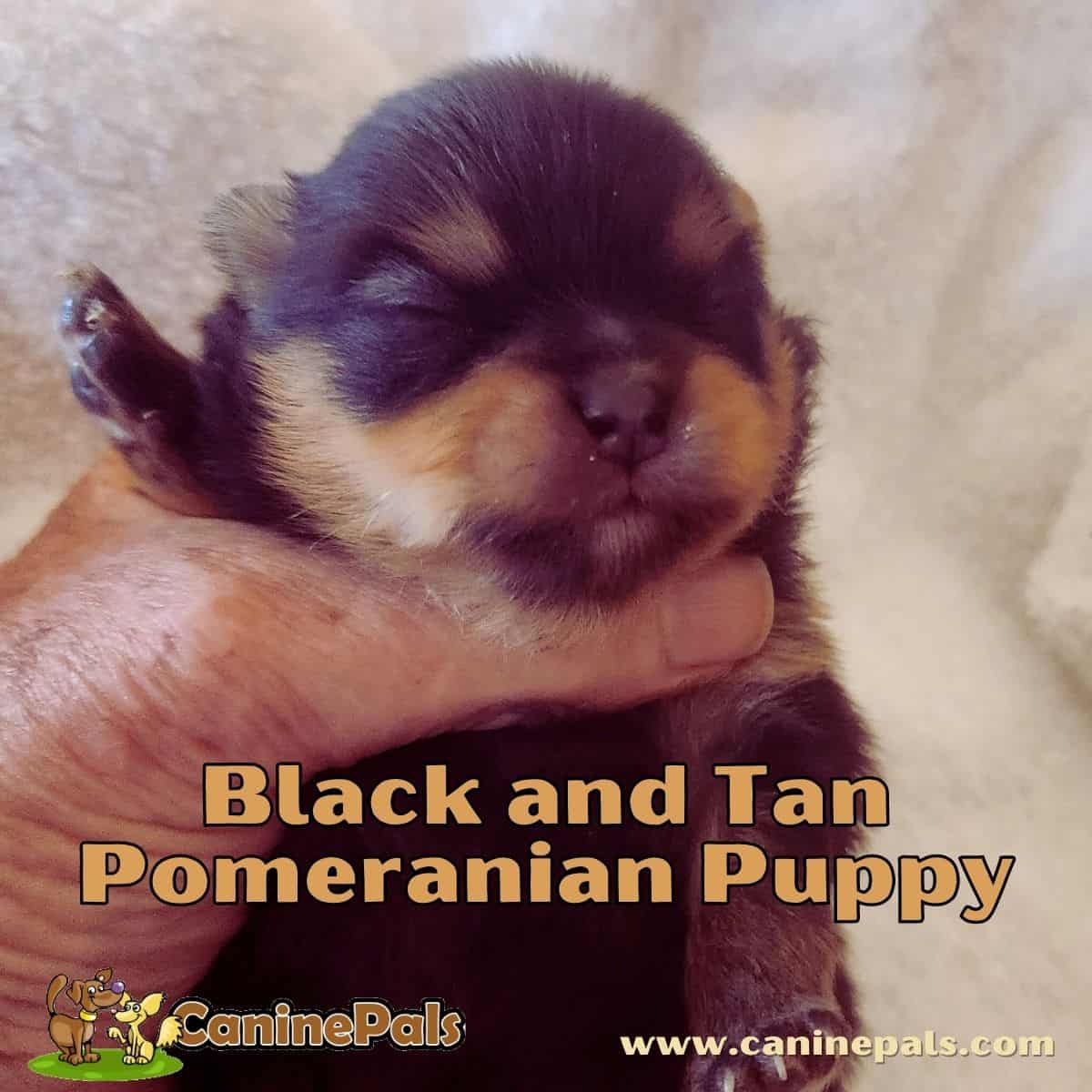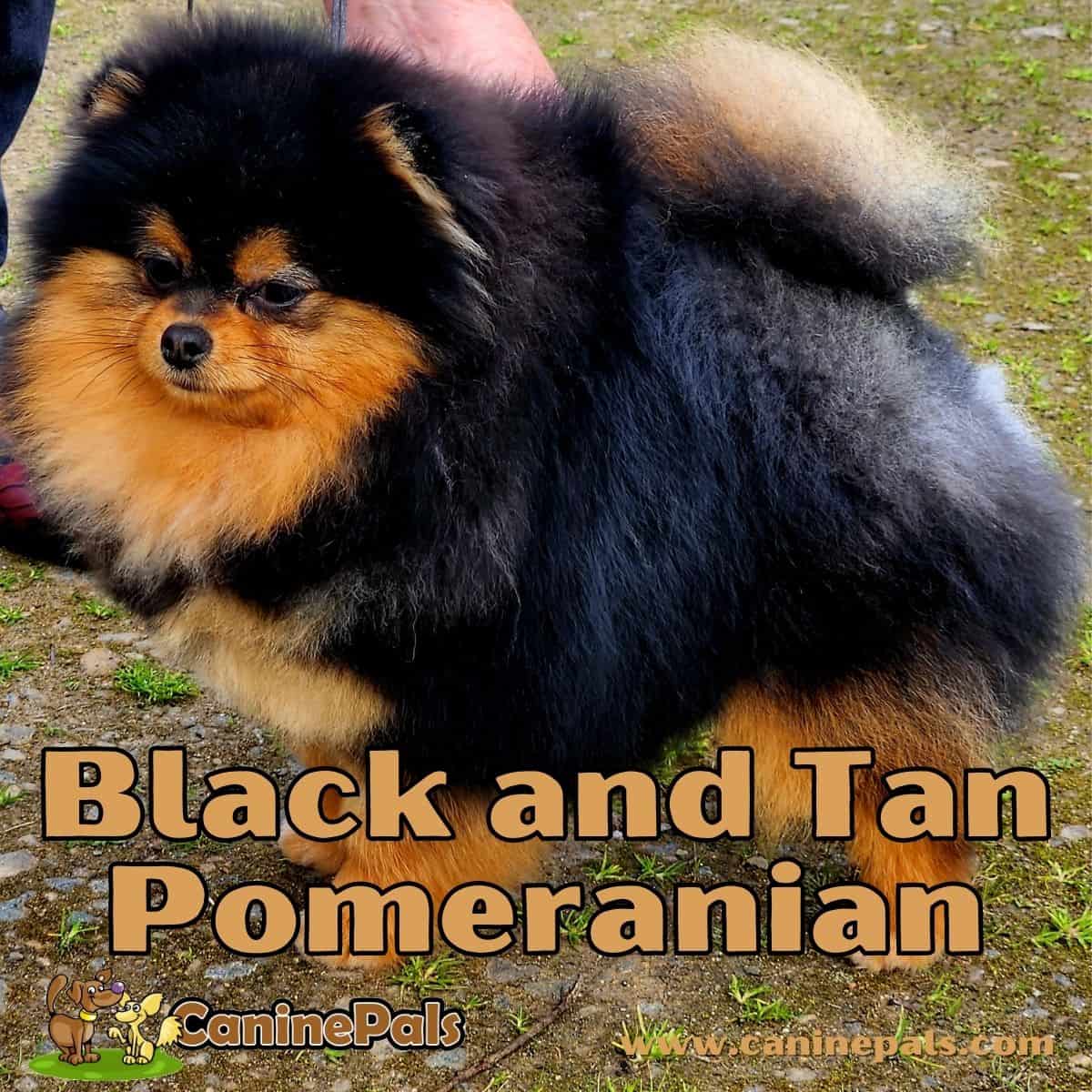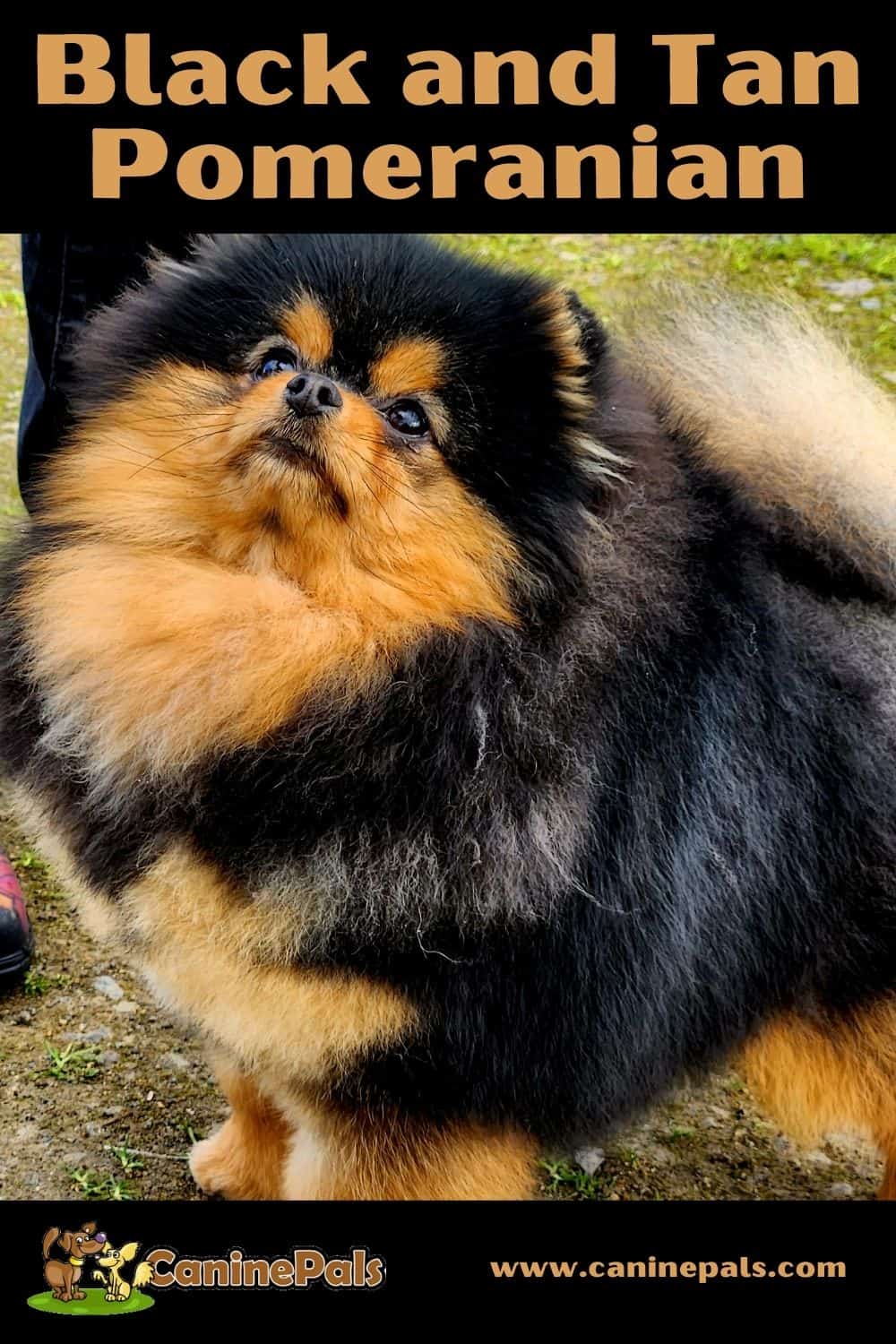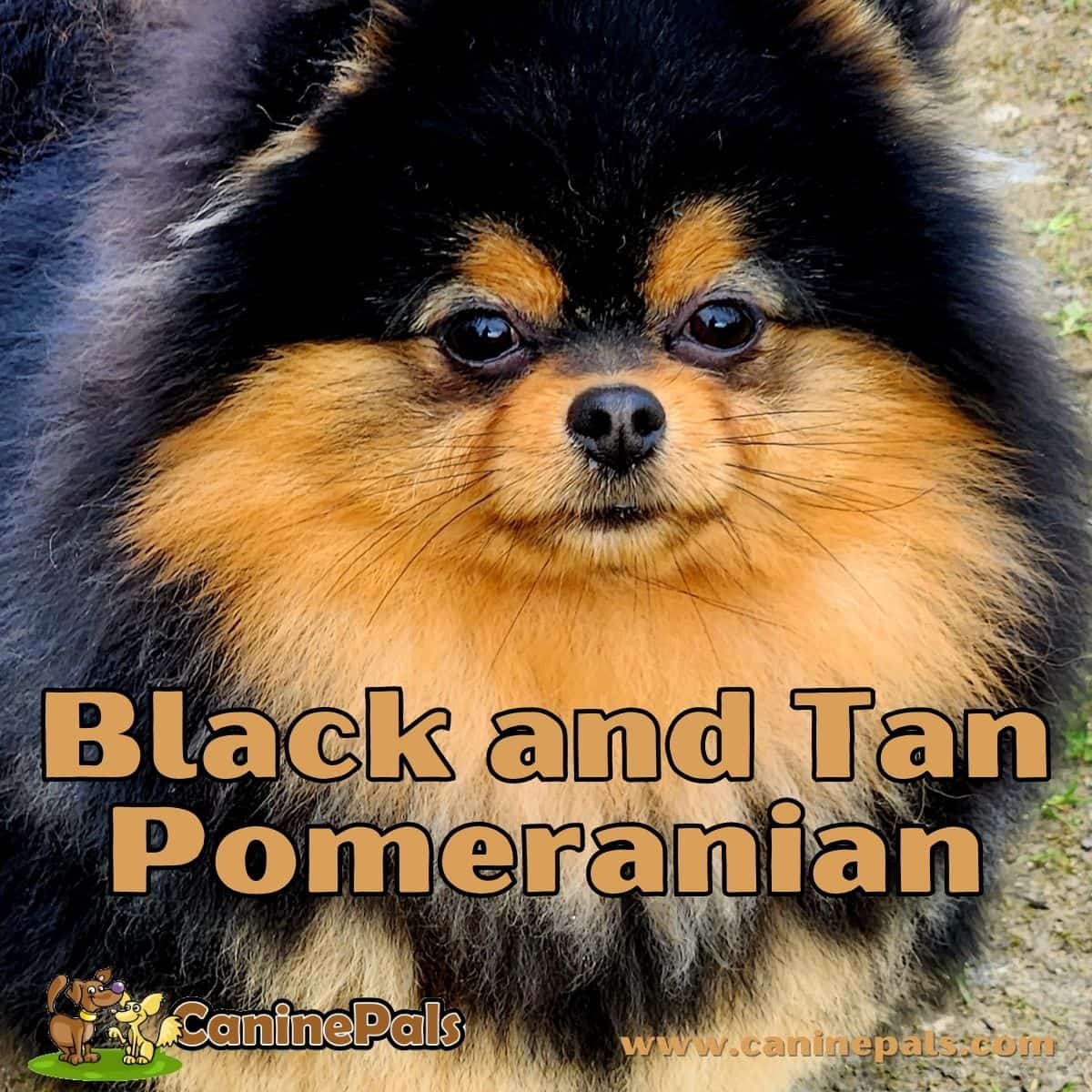Last Updated on March 19, 2024 by Denise Leo. Post first published on August 16, 2023.
Unlock the allure of Black and Tan Pomeranians at CaninePals.com! Dive into trusted insights, expert-backed secrets, and proven care tips. Click now! The Black and Tan Pomeranian is a popular color variation of the Pomeranian breed.
These small and adorable dogs are known for their lively and inquisitive personalities, making them a great addition to any family. This article will discuss everything you need to know about Black and Tan Poms, including their history, characteristics, and how to care for them.
Understanding the Pomeranian breed is essential when adding a Black and Tan Pomeranian to your family. Pomeranians are a toy breed originating in Germany. They were once larger sled and working dogs. They are known for their thick, fluffy coats and charming personalities.
Pomeranians are highly intelligent and love to learn new tricks, making the breed popular for dog owners who enjoy training their pets. Defining Black and Tan colored Pomeranians is important when discussing this color variation.
These dogs have a black coat with rust or tan pattern markings, with the points including eye rims, nose, lips, and pads being black. In Black and Tan Pomeranians, darker, rich tan pattern markings are preferred over lighter ones. Black and tan is one of the original Pomeranian color patterns.
Key Takeaways
- Black and Tan Pomeranians are a popular color variation of the Pomeranian breed.
- The American Kennel Club ( AKC) Pomeranian breed standard lists black and tan color patterns.
- Pomeranians are a toy breed originating in Germany and are known for their thick, fluffy coats and charming personalities.
- Black and Tan Pomeranians have a black coat with rust or tan pattern markings, with darker, darker rust markings preferred over lighter ones.
- Black and Tan Pomeranians must have black noses, black pigment, and black eye rims.

Defining the Black and Tan Pomeranian
Rich, dark tan patterns are favored over lighter shades in these Poms. Their distinctiveness is undeniable – the tan accents amplify their trademark eyebrows, enhancing their delightful charm. These pint-sized wonders share tan markings like those seen on Rottweilers or Doberman Pinschers.
One of the Pomeranian’s defining features is its black-and-tan pattern. It is a double coat that is thick, soft, and fluffy. The undercoat is short and dense, while the outer fur is longer and straight. This combination of coats gives the black-and-tan Pomeranian a plush, attractive, and functional appearance.

Color Variations in Pomeranians
Black and Tan Pomeranians boast deep black coats highlighted by rusty or tan points. Essential points like eye rims, nose, lips, and paw pads should be jet black. The Pomeranian dog come in a wide range of patterns and colors.
According to the American Pomeranian Club, there are 25 recognized colors and patterns for Pomeranians. These colors include black, red, white, cream, orange, blue, chocolate, brindle, wolf sable, cream sable, blue merle, blue sable, beaver, and more.
Whole-colored dogs are solid color and the most common Pomeranian coat colors. These include black Poms, red, white, cream, orange, blue Poms, chocolate, and the rare lavender. Parti-color Pomeranians have a white base color with patches of another color.
Tri-colored Pomeranians are parti-colored dogs with a white base color and patches of two other colors.
Black Pomeranians are one of the most popular Pomeranian colors. They have a solid black coat with no other colors or patterns.
Red Pomeranians have a solid red coat and are also a popular color. White Pomeranians have a solid white fur coat and are often seen in show rings. Cream Pomeranians have solid cream-colored coats and are also a popular color.
Orange Pomeranians have solid orange-colored fur and are similar to cream Pomeranians. Blue Pomeranians have solid blue hair and are a rarer Pomeranian color. Chocolate Pomeranians have solid chocolate-colored coats and are also a rare color.
Chocolate Pomeranians have a brown coat and are diluted black Poms.
Black and tan Pomeranians are black Pomeranians with rust or tan pattern markings. The points should be black, including eye rims, nose, lips, and paw pads. Darker, rich tan pattern markings are preferred over lighter tan ones in black and tan Poms.
Chocolate and tan Pomeranians have a chocolate-colored coat with tan pattern markings. Wolf sable Pomeranians have a gray or silver base coat with black-tipped guard hairs. Cream sable Pomeranians have a cream-colored base coat with black-tipped guard hairs.
Blue Merle Pomeranians have a blue-gray base coat with black patches. Blue sable Pomeranians have a blue-gray base coat with black-tipped guard hairs. Beaver Pomeranians have a beige base coat with self-colored points.
Chocolate sable Pomeranians have a chocolate-colored base coat with darker-tipped guard hairs and brown points. While lavender Pomeranians have a grayish-lavender base coat. It is important to note that some colors and patterns are more desirable than others, and rarity does not necessarily equate to desirability.
Sable Pomeranian dogs have black hairs, as in mostly black tips to the coat. Orange Sable is an orange base coat with black tips.
A light-cream Pom puppy is often confused with a solid-colored white Pom.
Blue eyes on a Pomeranian are a disqualifying fault.

Pomeranian Coat Color Genetics
Understanding the genetics behind Pomeranian coat colors is important for breeders and owners alike. Pomeranians can have a wide range of coat colors, including black and tan, and the genetics behind these colors are fascinating. Genetics greatly influence the coat color of a Pomeranian.
Multiple genes, such as the E locus, K locus, and B locus, contribute to this determination. The E locus is responsible for the yellowish or reddish coats and the black face masks.
The K locus is responsible for the dominant colors of fawn, brindle, and black, while the B locus is connected to the color brown, chocolate, and liver. The black and tan coat color is created by the tan point pattern, which is responsible for creating black and tan, as well as other variations such as blue and tan, chocolate and tan, and tri-color (black and tan parti).
A Pomeranian is considered black and tan if it carries two copies of the recessive a (t) gene. It’s important to note that two copies of the clear orange (e) gene can hide black and tan, creating a clear orange dog.
Pomeranian coat colors can change over time due to various factors, including sunlight and mismark. Sunlight can cause a Pomeranian’s coat to fade, especially in areas where the fur is thin. Mismarks are areas of the coat that do not match the breed standard, such as white markings or spots on a black Pomeranian.

Understanding the Pomeranian Breed
The American Kennel Club classifies Pomeranians as a toy breed. They are known for their small size, friendly temperament, and high energy levels.
Pomeranians were originally bred in the Pomerania region of Europe, now part of Poland and Germany. Pomeranians are popular with families and individuals looking for a companion pet. They are known for being loyal and affectionate towards their owners.
However, due to their small size, there may be better choices for families with young children who may accidentally harm them. In terms of energy levels, Pomeranians are a high-energy breed. Keep your Pomeranian healthy and happy with regular exercise and playtime.
They are versatile and can thrive in any living situation, from apartments to small homes. When it comes to temperament, Pomeranians are generally friendly and outgoing. Beings vocal and barking to alert their owners of danger are their trademarks.
But with training, excessive barking can be avoided. Overall, Pomeranians make excellent companion pets for individuals and families willing to provide them with the proper care and attention they need. With their friendly temperament, high energy levels, and adaptability, they can make wonderful additions to any household.

Frequently Asked Questions
Are black and tan Pomeranians rare?
Black and tan Pomeranians are not considered rare but less common than other Pomeranian colors like orange and cream. However, they are still a popular choice among Pomeranian enthusiasts.
What is the rarest color of Pomeranian?
Rare Pomeranian colors are lilac or lavender, brindle and more. The rarest color of Pomeranian is the lavender or lilac color. This color results from a recessive gene and is not commonly found in Pomeranians.
What are black and tan Pomeranians called?
Black and tan Pomeranians are sometimes incorrectly called “parti-color” Pomeranians because of their two-tone coloring. They are also sometimes referred to as “bi-colored” Pomeranians.
Where can I find black and tan teacup Pomeranians for sale?
“Teacup Pomeranian” is an unofficial term and often a red flag. Advertisements using this label are typically associated with scams or unscrupulous practices. We recommend looking for a breeder who is a member of the American Pomeranian Club and has a good reputation. Also, check with animal shelters and rescue organizations to see if any black and tan Pomeranians are available for adoption.
How much do black and tan Pomeranians typically cost?
The price of a black and tan Pomeranian fluctuates based on various elements, such as the breeder’s reputation, geographical location, and the dog’s age. However, on average, you can expect to pay between $1,000 and $6,000 for a black and tan Pomeranian.
What is the temperament of black and tan Pomeranians?
Black and tan Pomeranians have a similar temperament to other Pomeranians. They are generally friendly, outgoing, and intelligent dogs.
They are also known for being loyal and affectionate with their owners. However, like all dogs, their temperament can be influenced by their upbringing and training. Proper socialization and exercise are important for any dog, including black and tan Pomeranians.
Conclusion
In conclusion, the Black and Tan Pomeranian is a magnificent specimen within the canine world, combining a dazzling aesthetic and affectionate demeanor. This breed is distinguished by its striking black and tan coat, which showcases fine markings and a hue that speaks to its unique genetic makeup.
Each Black and Tan Pomeranian exhibits distinct facial features, with the required nose and skin pigment enhancing their expressive eyes and contributing to their overall charm. Their coat, notably at the top of each toe, adds to their allure, embodying the breed’s well-regarded elegance.
Beyond their physical beauty, these Pomeranian pups are cherished for their spirited and loyal nature. Despite their petite size, they possess an adventurous heart, making them excellent companions for families, including those with children. Their curious and feisty personalities and unwavering loyalty make them not just pets but treasured household members.
For those seeking a furry friend that offers visual beauty and a joyful presence, the Black and Tan Pomeranian is an unparalleled choice. With the proper care, attention, and love, they reciprocate with unconditional affection, filling homes with warmth and happiness.
Consider welcoming a black-and-tan Pomeranian into your life if you are looking for a delightful, loyal companion who captures elegance and spiritedness. This dog breed enhances your daily experience with its vibrant personality and adds a touch of grace to your home with its exquisite appearance.
Copyright CaninePals.Com. All Rights Reserved.
References and Further Reading:
- Official Standard of the Pomeranian (AKC). American Kennel Club, 2011.
- Official English Kennel Club Pomeranian Breed Standard, 2017.
- Kimbering Pomeranians “1891-1991”.
- Denise Leo, The Pomeranian Handbook.
- L.Ives, Show Pomeranians.
- L.Ziegler Spirer & H.F. Spirer, This is the Pomeranian.
- FEDERATION CYNOLOGIQUE INTERNATIONALE (FCI) German Spitz, including Keeshond and Pomeranian Breed Standards. PDF file.
The Pomeranian Handbook by Denise Leo



